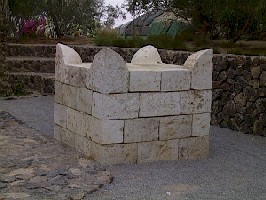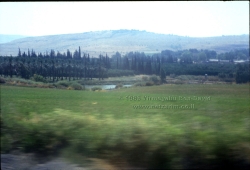Lëkh Lᵊkhâ 2nd Eve

AvᵊrâmꞋ, A Wealthy Baron, Moves Back To The NëgꞋëv
 |
So AvᵊrâmꞋ, Sâr•aiꞋ and his nephew, Lōt, with their fortunes in herds of various kinds of livestock, as well as fortunes in silver and gold, assembled a caravan and moved out of Egypt. The family passed through the NëgꞋëv and returned to their previous homestead at Eil•onꞋ Mor•ëhꞋ where he had originally built a mi•zᵊbeiꞋakh (between Beit-Eil and Ai, halfway between ShᵊkhëmꞋ and Yᵊru•shâ•laꞋyim, in Kᵊna•anꞋ). It was there that AvᵊrâmꞋ called ä' by Name.
Family Feud Threatens To Descend Into A Range War
 |
Lōt likewise returned independently wealthy, with many herds and tents of workers and maids. But there were too many herds and animals for the amount of land in the area. There wasn't enough pasture for all of the animals of both families to graze. As the grasses were devoured by the overstocking of animals, range wars broke out between the cattlemen and shepherds of the two families.
AvᵊrâmꞋ convened a pow-wow between himself and Lōt to agree together on a solution before the situation deteriorated into bloodshed.
Then AvᵊrâmꞋ proposed to Lōt, "Let's not have a range war between family members. There's plenty of land out there. You and your cowboys and shepherds take your herds and flocks one way to graze and I and my cowboys and shepherds will take our herds and flocks to graze in the other direction. Take your pick."
The Price Of Putting Work Before QoꞋdësh
 250x167.jpg) |
So Lōt chose to graze his herds and flocks in the District of Ya•rᵊd•einꞋ, grazing and camping east and south, through Yᵊri•khoꞋ and along the east shore of Yâm ha-MëlꞋakh as far as the city of Sᵊdom, which was ruled by the king of Iran.
In making his decision, Lōt ignored the influence that the residents of Sᵊdom would have on him and his family. The residents of Sᵊdom were widely known as brazen wrong-doers and idolatrous transgressors against ä'.
ä' Deeds Kᵊna•anꞋ to AvᵊrâmꞋ
 |
Since Lōt had chosen the District of Ya•rᵊd•einꞋ and the east shore of Yâm ha-MëlꞋakh, this left AvᵊrâmꞋ and his cowboys and shepherds to graze their flocks on the west side of Yâm ha-MëlꞋakh in Kᵊna•anꞋ, among the mountains of YᵊhudꞋâh, south to Khë•vᵊr•onꞋ. Now the east shore of Yâm ha-MëlꞋakh was ruled by the king of Iran, while Kᵊna•anꞋ was governed by a string of smaller, independent city-kings.
After Lōt and his family had moved all their possessions, herds and flocks, settling near Sᵊdom, AvᵊrâmꞋ envisioned ä' granting all the land around Eil•onꞋ Mor•ëhꞋ to him and his descendants, as far as he could see in all directions, grazing throughout the length and breadth of the land; promising AvᵊrâmꞋ that He would multiply his descendants beyond numbering, like the grains of sand on the earth.

Optional parental preparation:
- Try to find videos of a working cattle ranch, goat herding and shepherding to show.
- Review, with the child, on a globe, the areas in which story took place. (principally the area north of, and halfway down the east shore of Yâm ha-MëlꞋakh to Sᵊdom (Lōt) and YᵊhudꞋâh south to Khë•vᵊr•onꞋ (Av•râmꞋ).
Questions you might anticipate that your child might raise and be prepared to discuss:
- What's a baron?
- What's the NëgꞋëv?
- What's a range war? (Like in the American Old West)
- What does "holy" mean?
- What is idolatry? (any physical representation of a
god)
Google+ registered author & publisher

